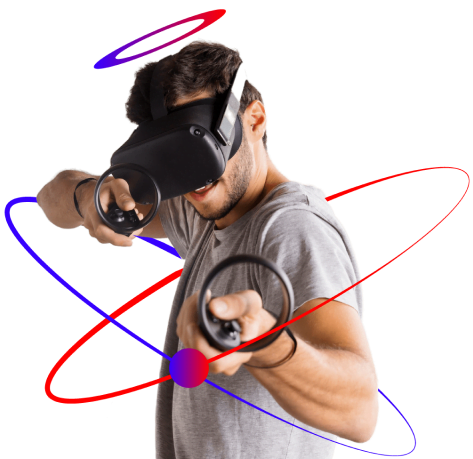Industries
Gaming
Gaming Industry
Information technology has revolutionized the gaming industry with gameplay mechanics and graphics rendering to multiplayer experiences. It has redefined the field of gaming in the way it is developed, played, and shared. Cloud gaming enables instant access to games on various devices, transcending hardware limitations.
AI enhances non-player character behavior and procedural content generation. In-game purchases and virtual economies have emerged, driven by IT systems. Streaming platforms showcase gameplay to global audiences, creating new avenues for entertainment.

Information technology continues to push the boundaries of creativity and interactivity in the Gaming Industry, shaping its trajectory toward immersive, interconnected, and innovative gaming experiences.
Gaming Industry IT Challenges

There are still challenges for the gaming industry such as network stability which is crucial for robust infrastructure in online multiplayer gaming.
Cybersecurity is a threat to personal data and in-game valuable assets. In diverse gaming devices and platforms, there are several compatibility issues. Game performance requires a balance of software and hardware development. Advanced algorithms are essential to address player grievances, online interactions, and countering cheating necessitate.
An efficient content delivery system is essential in managing the demand for games in the ever-growing gaming industry. These multifaceted challenges need to be addressed for secure, enjoyable, and seamless experiences for diverse players, around the globe.
How Aerial Teknology is Helping the Gaming Industry?
Aerial Teknology is a one-stop solution for digital services including web development, app development, logo & branding, video & animation, marketing, and business process outsourcing. The company is comprised of a competent team of marketers, analysts, developers, and artists who have a wealth of experience in working on the projects of companies of all sizes. Aerial Teknology provides services that aid the transformation of the gaming industry from developing the games to marketing and distribution. These services have not only enhanced the player’s journey but also provided new avenues for innovation, community engagement, and revenue generation.
Distribution and Accessibility
Digital services have eliminated the need for physical copies of games, allowing players to download titles directly onto their devices. This has led to a more convenient and instantaneous gaming experience, minimizing the need to wait for shipments or visit retail stores.
Cloud gaming services have taken this a step further, enabling gamers to stream games in real time without the need for powerful hardware, making high-quality gaming accessible to a broader audience.


Monetization Models
Digital services have introduced diverse monetization models beyond traditional retail purchases. Free-to-play games, supported by in-game purchases, microtransactions, and virtual goods, have become increasingly prevalent.
This model allows players to enter the game without any upfront cost and spend money on cosmetic items, power-ups, or additional content. This approach not only generates substantial revenue for developers but also provides players with the flexibility to spend according to their preferences.
Community and Engagement
Digital services have fostered vibrant gaming communities through online multiplayer features, social integration, and esports. Aerial Teknology develops games where players can connect with friends, form teams, and compete on a global scale.
Streaming platforms like Twitch and YouTube Gaming enable gamers to share their experiences, strategies, and gameplay, creating a unique form of interactive entertainment. Esports tournaments have gained immense popularity, showcased the competitive aspect of gaming, and drew large audiences.


Continuous Updates and Content
Aerial Teknology enables developers to deliver updates, patches, and new content seamlessly. This “Games as a Service” model ensures that games remain relevant long after their initial release. Players can enjoy new levels, characters, modes, and events that keep the experience fresh and engaging, contributing to longer player retention and increased revenue streams.
Data-Driven Insights
Aerial Teknology aids gaming platforms by gathering extensive player data and gaining insights into player behavior, preferences, and pain points. This information helps refine game mechanics, improve user experiences, and tailor marketing strategies. Data-driven insights enable developers to create more personalized and engaging content, enhancing player satisfaction and loyalty. Aerial Teknology has transformed the gaming industry by reshaping distribution, monetization, engagement, and community dynamics.
As the industry continues to evolve, these services will likely play an even more pivotal role, pushing boundaries and shaping the future of gaming. Data-driven insights improve the gaming experience of online players, making it more exciting for the gaming community. Insights allow understanding the needs and preferences of players and developing games that will give a lasting experience to this community. Aerial Teknology allows the gaming community to explore new trends in gaming with the integration of the latest development and graphic tools.
Animation and Video Editing
The digital services allow marketing and promotion of the new games with the assistance of appealing visuals and animation. Animations allow players to grasp the essence of the game visually. The video advertisements expand the market reach of the new games and help new brands emerge within an already saturated market. Currently, Virtual Reality (VR) is a powerful tool in the gaming industry that has changed the course of the gaming industry with features that give a real-life experience.
Future of IT in the Gaming Industry
The future of IT in the Gaming Industry is poised to be a dynamic convergence of cutting-edge technologies, reshaping how games are played, created, and experienced. Artificial Intelligence (AI) will power advanced procedural content generation, leading to immersive and ever-evolving game worlds. Real-time ray tracing and enhanced graphics capabilities will create stunning visual realism, blurring the line between virtual and reality.
Cloud gaming will become mainstream, enabling players to access high-quality gaming experiences on various devices, while 5G networks will ensure seamless and responsive online multiplayer interactions.
- Virtual and augmented reality (VR/AR) will unlock new dimensions of immersion, enabling players to physically engage with virtual environments.
- Blockchain technology may revolutionize in-game economies, offering secure and transparent item ownership and trading.
- Player customization will reach new heights, with AI-generated avatars tailored to individual preferences. Collaborative AI-driven narratives will offer personalized storytelling experiences.
Data security and privacy concerns will demand robust solutions, especially with the influx of player data. Ethical considerations will arise around AI-driven content generation and decision-making. Developers will need to strike a balance between innovation and maintaining the essence of traditional gaming experiences. In essence, the future of IT in the Gaming Industry promises a captivating fusion of innovation and entertainment, redefining how players engage with virtual worlds and narratives while pushing technological boundaries.


